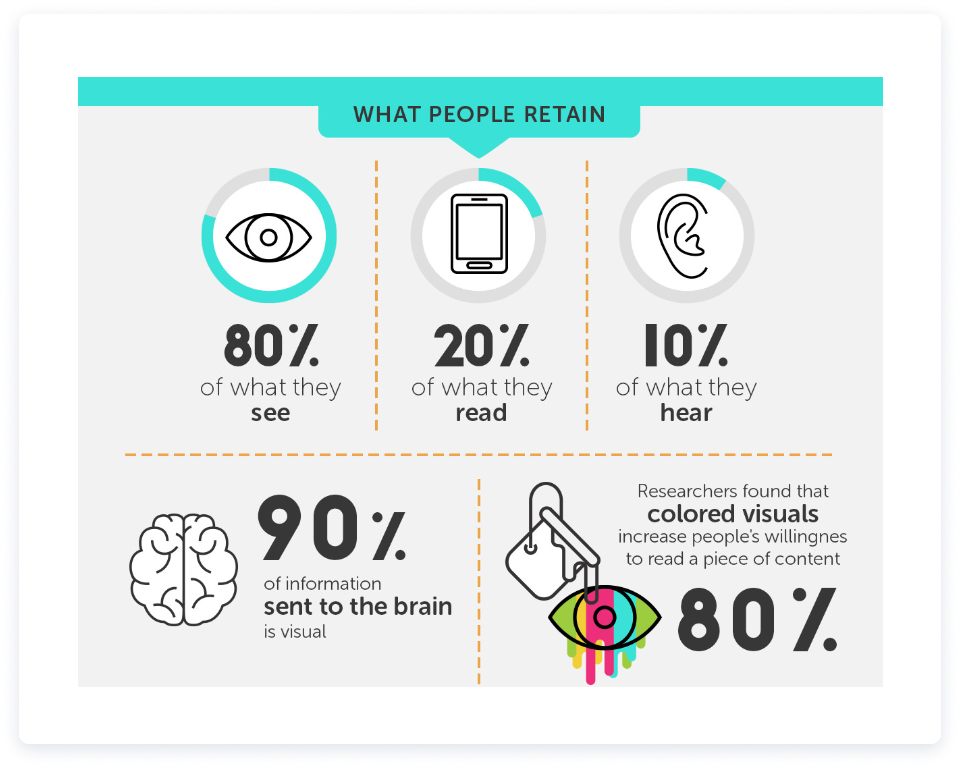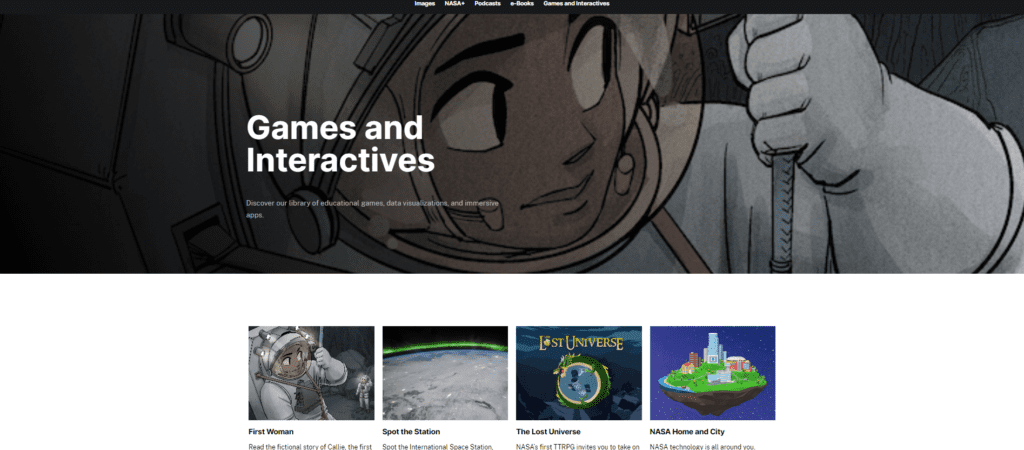Interactive visuals are the new normal. They are a crucial part of your content marketing strategy today. From immersive multimedia experiences to dynamic data visualizations, interactive visuals offer plenty of creative avenues for content creators to explore.
In this article, we will explain the diverse array of techniques and technologies available to craft interactive visuals that not only grab attention but also leave a lasting impact on viewers, as well as some real-life examples of how to use interactive visuals.
So, let’s begin!
Why Interactive Visuals
With the constant influx of information bombarding individuals daily, the demand for engaging and entertaining content has skyrocketed in recent times. One powerful method to meet this demand is through the utilization of interactive visuals.
These innovative tools not only capture attention but also foster meaningful engagement by allowing audiences to actively participate in the content they consume.
Benefits of Using Interactive Visuals in Engaging Audiences
Using interactive visuals to engage audiences offers numerous benefits.
- Firstly, they enhance comprehension and retention by presenting complex information in a visually appealing and interactive format, catering to different learning styles and cognitive preferences.
- Secondly, interactive visuals promote active participation, encouraging audiences to explore content at their own pace, leading to higher engagement levels and better information absorption.
- Additionally, they foster memorable experiences, as interactive elements stimulate curiosity and create opportunities for hands-on learning, thereby increasing audience satisfaction and facilitating deeper connections with the material presented.
Overall, leveraging interactive visuals enhances communication effectiveness, making it an invaluable tool for engaging and captivating audiences across various contexts. For example, incorporating an Android SMS forwarder into your strategy provides a seamless way to manage communications and maintain engagement with your audience.

Here are more Content Marketing Statistics that could be valuable for your visual content marketing strategies.
AR and VR Techniques for Creating Interactive Visual Content
Augmented Reality (AR) and Virtual Reality (VR) are immersive technologies that blend digital content with the real world (AR) or create entirely simulated environments (VR).
AR overlays digital information onto the user’s view of the physical world through devices like smartphones or AR glasses. Whereas, VR replaces the user’s environment with a fully digital one, typically experienced through headsets.
Tips for Incorporating AR and VR into Content Creation
- Identify how AR or VR experiences can enhance your audience’s engagement with your brand or content.
- Ensure that your AR or VR content is intuitive and easy to navigate, providing clear instructions and guidance.
- Use AR and VR technologies to tell compelling stories and create memorable experiences for your users.
- Continuously gather feedback and data to refine your AR or VR experiences, improving usability and effectiveness over time.
- Work with experienced developers and designers who specialize in AR and VR to leverage their expertise and ensure the quality of your interactive content.
Interactive Infographics and Data Visualizations
Several innovative tools are available on the market that help you create interactive visuals seamlessly.
- Tableau is a powerful data visualization tool that allows you to create interactive dashboards and visualizations. Tableau Public is a free version that lets you publish your work online.
- Infogram is a web-based tool that allows you to create interactive infographics and charts. It offers a user-friendly interface with various customization options.
- Canva offers a range of templates and tools for creating infographics, including interactive elements. It’s easy to use and suitable for users with different design skill levels.
Interactive Video Content
Interactive video content is incredible. Marketers can use innovative ideas to create video content to keep the audience engaged.
- Adobe Premiere Pro is a professional video editing software that allows you to create interactive video content. You can add interactive elements using its timeline-based editing features.
- H5P is an open-source platform that enables you to create interactive videos by adding overlays, quizzes, and other interactive elements to your videos.
- WIREWAX is a platform specifically designed for creating interactive videos. It offers features like clickable hotspots, branching narratives, and analytics to track viewer engagement.
Interactive Quizzes and Games
Quizzes and games encourage analytical thinking among the teams and target audience. Below are some of the tools businesses can use to educate audiences and provide immersive experiences.
- Quizizz is an online platform that allows you to create and share interactive quizzes. It’s popular among educators but can be used for various purposes, including marketing and training.
- Kahoot! is another platform for creating and playing interactive quizzes, surveys, and polls. It’s widely used for educational purposes and corporate training.
- Unity is a game development platform that enables you to create interactive games with 2D or 3D graphics. It requires some programming knowledge but offers extensive capabilities for creating immersive experiences.
Best Practices for Creating Engaging Interactive Visuals
Creating engaging interactive visuals involves careful planning and execution to ensure that they effectively capture the audience’s attention and encourage interaction. Here are some best practices for creating engaging interactive visuals:
Know Your Audience
Understand the demographics, interests, and preferences of your target audience to tailor your visuals accordingly. This will help you create content that resonates with them and encourages engagement.
Keep It Simple
Avoid overwhelming your audience with too much information or complex visuals. Keep your designs clean and concise, focusing on the key points you want to convey.
Use Compelling Visuals
Choose high-quality images, videos, and graphics that are visually appealing and relevant to your content. Use colors, fonts, and other design elements strategically to enhance the visual appeal of your interactive visuals.
Make It Interactive
Incorporate interactive elements such as clickable buttons, sliders, and animations to encourage engagement and make the experience more immersive for users. Allow users to explore the content at their own pace and interact with different elements to enhance their understanding.
Provide Clear Navigation
Ensure that your interactive visuals are easy to navigate and intuitive to use. Provide clear instructions and guidance to help users navigate through the content and understand how to interact with different elements.
Offer Valuable Content
Provide meaningful and valuable content that educates, entertains, or solves a problem for your audience. Make sure that your interactive visuals offer something of value to users to encourage them to engage with the content.
Optimize for Mobile
With an increasing number of users accessing content on mobile devices, it’s essential to optimize your interactive visuals for mobile responsiveness. Make sure that your visuals are mobile-friendly and provide a seamless experience across different devices by considering the option to hire a UX designer.
Test and Iterate
Continuously test your interactive visuals with your target audience and gather feedback to identify areas for improvement. Use analytics and user testing to evaluate the effectiveness of your visuals and make adjustments as needed to enhance engagement.
Examples of Successful Interactive Visual Content
Here are some examples of brands that have successfully utilized interactive visual content:
NASA
NASA regularly creates interactive visual content to engage its audience and educate them about space exploration. They have interactive simulations, virtual tours, and interactive maps that allow users to explore different planets, moons, and spacecraft.

National Geographic
National Geographic is known for its stunning visual content, and they have taken it a step further by creating interactive experiences. For example, they have interactive maps that allow users to explore different ecosystems around the world, interactive timelines that showcase historical events, and interactive documentaries that provide immersive storytelling experiences.

IKEA
IKEA has implemented interactive visual content on its website to enhance the shopping experience for customers. For instance, the kitchen planner tool allows users to design their kitchens by selecting different cabinets, appliances, and accessories, and visualizing how everything will look together in 3D.
Challenges and Considerations
Creating interactive visual content that effectively engages and entertains your audience comes with its own set of challenges and considerations. Here are some key ones:
Content Relevance
Interactive visual content should be relevant to your target audience and aligned with your brand message. It’s important to understand your audience’s interests, preferences and needs to create content that resonates with them. Irrelevant or off-topic content may fail to capture their attention or drive engagement.
Technical Constraints
Developing interactive visual content often involves complex technical implementations, especially for more advanced features such as animations, simulations, or data visualizations. It’s essential to have the necessary technical expertise or collaborate with professionals who can execute your vision effectively.
Performance Optimization
Interactive content may require significant resources in terms of bandwidth and processing power, especially for web-based experiences. Optimizing performance is crucial to ensuring smooth and seamless user interactions, minimizing loading times, and avoiding issues such as lag or stuttering.
Accessibility
Accessibility is an important consideration for interactive visual content to ensure that it can be enjoyed by all users, including those with disabilities. Providing alternative text for images, ensuring keyboard navigation, and adhering to web accessibility standards are essential practices to make your content inclusive.
Engagement Metrics and Analytics
Measuring the effectiveness of interactive visual content requires tracking relevant metrics such as engagement rate, time spent, and interactions. Implementing analytics tools and gathering feedback from users can provide valuable insights into how well your content is performing and where improvements can be made.
Content Maintenance and Updates
Interactive visual content may require ongoing maintenance and updates to keep it relevant and up-to-date. This includes fixing bugs, adding new features, or refreshing the content to prevent it from becoming stale or outdated.
Conclusion
The utilization of interactive visuals presents a dynamic and compelling approach to captivating audiences across various platforms. Through innovative tools and techniques, content creators have the opportunity to not only engage their audience but also entertain them in memorable ways.
By leveraging interactive elements such as animations, infographics, and immersive experiences, brands can forge deeper connections with their viewers, leading to increased retention, brand loyalty, and ultimately, success in today’s competitive digital ecosystem.

